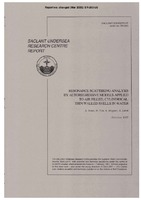| dc.contributor.author | Tesei, Alessandra | |
| dc.contributor.author | Fox, Warren L. J. | |
| dc.contributor.author | Maguer, Alain | |
| dc.contributor.author | Lovik, A. | |
| dc.date.accessioned | 2018-10-11T14:08:35Z | |
| dc.date.available | 2018-10-11T14:08:35Z | |
| dc.date.issued | 1997/10 | |
| dc.identifier | 11871 | |
| dc.identifier.govdoc | SR-265 | |
| dc.identifier.uri | http://hdl.handle.net/20.500.12489/485 | |
| dc.description.abstract | Autoregressive (AR) parametric spectral estimation of the scatterer transfer function is applied to the analysis of acoustic scattering by elastic objects. In accordance with Resonance Scattering Theory (RST), the specular and resonance components of the scattering field are differentiated. AR models and consequent resonance analysis are applied to both the global scattering response and to the resonance component separately. The AR-based representation is useful for detecting and localizing resonances in the frequency domain. The capability of AR models to estimate resonance frequencies accurately is shown. Among the extracted poles of the AR model, a subset of resonance frequencies is selected and processed in order to characterize a scattering object in terms of geometrical and geophysical parameters on the basis of analytical matching relations, derived from the RST. The targets considered are elastic, cylindrical, thin walled shells in water under free-field conditions. Analysis is performed on simulated and real data in the ka range (0,501). | |
| dc.format | 68 p. : ill. ; 37 fig. | |
| dc.language | English | |
| dc.publisher | NATO. SACLANTCEN | |
| dc.relation.ispartofseries | ADA344638 | |
| dc.subject | Free-field target acoustic scattering | |
| dc.title | Resonance scattering analysis by autoregressive models applied to air-filled, cylindrical, thin walled shells in water | |
| dc.type | Scientific Report (SR) | |
